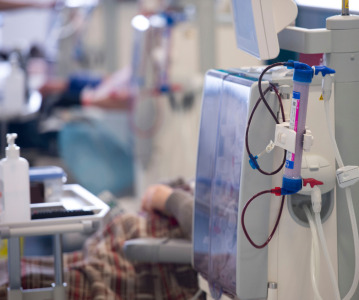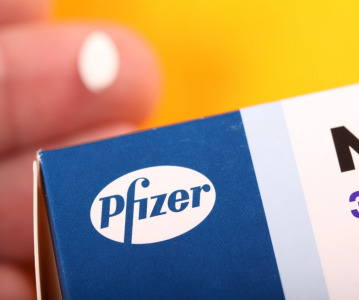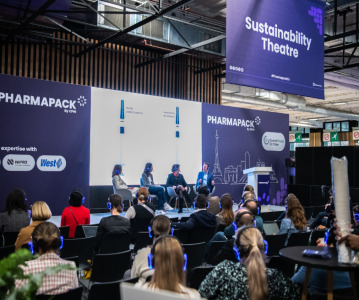How GLP-1 agonists are reshaping drug delivery innovations
.png)
GLP-1 agonist drug products like Ozempic, Wegovy, and Mounjaro have taken the healthcare industry by storm in recent years. Originally conceived as treatment for Type 2 diabetes, the weight-loss effects of these products have taken on unprecedented interest from consumers and the wider public arena.
Glucagon-like peptide-1 (GLP-1) receptors (GLP-1R) form a vital part of the G protein-coupled receptor (GPCR) family, and interacts specifically with GLP-1 hormone, playing a crucial role in the regulation of blood glucose levels and lipid metabolism, among other function [1]. GLP-1 drug products have now become a breakthrough for many pharmaceutical companies and their partners not only for the high demand in weight-loss drug products but also for potential applications in other fields such as inflammation reduction, enhancement of cardiovascular function, and more [1].
However, the surge in demand for GLP-1 drug products has caused various supply chain shortages in response [2]. The World Health Organization (WHO) has reported diabetes a global epidemic, with over 95% of those diagnosed with diabetes having Type 2 [3]. By 2050, the prevalence of Type 2 diabetes is expected to reach 1.27 billion people worldwide, approximately 9.5% of the world population diagnosed with diabetes [3]. Additionally, the demand for prescription and over-the-counter (OTC) weight-loss medications is further straining the GLP-1 supply chain [3].
Companies and regulatory agencies are taking measures to address the ongoing shortages of GLP-1 agonists, often with innovations in manufacturing, packaging, and drug delivery devices. This article will take an in-depth look at the trends related to GLP-1 agonist pharmaceuticals, with an emphasis on primary packaging containers, drug delivery innovations, and what this may mean for the future of these drug products.
Delivering blockbuster promises
More than just a headline, GLP-1 drug products have taken the pharmaceutical and healthcare industries by storm – predicted investments in these products are expected to soar to USD$150 billion by the early 2030s [4]. With such a massive opportunity at their fingertips, companies are contending with what increased consumer demands means for the supply chain like never before. In our 2025 Pharma Trends Outlook, Molly Bowman, Head of Strategy for Pharmaceutical Supply chain Management at Clarivate, commented that “The increasing popularity of GLP-1 agonists like Wegovy, Ozempic, and Zepbound have significant implications for the pharmaceutical supply chain. Increasing demand for these treatments strains manufacturing capacity and distribution channels, as well as requiring increased production. These synthetic peptides require specialised production facilities and temperature-controlled logistics, which adds complexity and cost to the supply chain. As more companies develop GLP-1 agonists and as competition increases, companies will need to improve their supply chain efficiency to stay competitive.”
One area of particular interest for the pharmaceutical supply chain is innovations in the packaging and delivery of GLP-1 agonists. Currently, these drug products are delivered via subcutaneous injections and remain the leading route of administration as of 2025 [5]. With a growing call for at-home administration and remote clinical studies, there is a push for drug manufacturers and delivery companies to investigate other methods of administration [5]. As the variety of available peptide and biologic drugs become available, there is a great opportunity for innovation in drug delivery and packaging. Alternative routes of administration for such drug products could include transdermal, pulmonary, and oral delivery. Many companies are already investigating oral delivery of GLP-1 agonists – UK-based Verdiva Bio recently launched into the market as a clinical-stage biopharmaceutical company focused on obesity drugs, as well as various cardiometabolic disorders [6]. Their portfolio includes assets licensed from Sciwind Biosciences, a China-based company granting global rights outside Greater China and South Korea for products such as a Phase II-ready oral GLP-1 agonist, ecnoglutide [6].
Companies looking to differentiate themselves within the GLP-1 agonist market through drug delivery and packaging innovations will have to consider how best to capitalise on the opportunities available. One area of focus, for example, may be enhancing patient experience when administering the product. Self-administration of injectables is not often the most patient-friendly route of drug delivery given patient phobias regarding needles, the complexity of injectables packaging and devices, and proper disposal of biohazardous waste [7]. A particularly challenging aspect of oral delivery of peptides and biologics like GLP-1 agonist products is degradation within the digestive tract [8].
Several investigations into solutions to this issue are in the works. For example, researchers from MIT and Novo Nordisk have worked together to develop an oral capsule that delivers large protein drug molecules by releasing a burst of the drugs into the gastrointestinal (GI) lining of patients [8]. Inspired by siphon organs in cephalopods, the API is encapsulated in small devices to protect the drug from degradation before being injected directly into the digestive tract lining [8]. This needle-free delivery shows potential for use in delivering GLP-1 drug products, which would make it easier for patient to take the drugs at home and improve adherence [8].
Another study from 2021 by AstraZeneca researchers investigated formulations of GLP-1 receptor agonists specifically engineered for oral delivery, adjusting the protein binding without affecting potency of the API [9]. While there is still work to be done in such novel approaches of peptide APIs like GLP-1 agonists, such innovations in macromolecule drug delivery demonstrate the growing opportunities for drug companies in drug delivery innovation.
Sustainable drug delivery and market growth
As with any scalable manufacturing and production process, increasing the availability of GLP-1 drugs also brings into question the sustainability of these processes and waste management [10]. In order to meet current demand, single-use autoinjectors and cartridge-based injector pens are the most popular mode of administration for GLP-1 drug products [10]. However, with the GLP-1 market poised to continue growing through to the next decade, the environmental impact of continuing to use single-use injector is being called into question. An estimate by JP Morgan puts the number of patients to be treated for diabetes and/or obesity at nearly 30 million by 2030 [11]. While some of these cases may be treated by the aforementioned oral treatments, this number could still mean almost one billion injections per year [10]. How can environmentally sustainable drug delivery solutions be developed for self-injection or easier self-administration of medications?
Some of the more obvious solutions to reducing waste and enhancing the sustainability of the packaging would be to reduce the amount of materials used during manufacture [10]. Components that are bio-based or biodegradable are a major point of investigation for packaging and delivery innovators, however may come with a significant investment to develop and manufacture at scale [10]. Circularity of devices, wherein the device is returned and recycled for future use or disassembly is another area of focus, with pilot trials in waste collection of devices with sharps and materials that have come into contact with biohazardous elements [10]. Again, the issue remains in the full scalability of these procedures, which may take several years from now to mature into a viable option [10].
Reusable injectors and other drug delivery systems are another potential option for more sustainable delivery of GLP-1 products [10]. While patients will need to load the device themselves between uses, such devices can contain components that hide the needle before and after injection, easing anxiety around regular doses [10]. The environmental impact will also be significantly reduced with each dosage. Future investment in such devices will have to focus on seeking cost-friendly electromechanical components that can deliver such viscous drug formulations, as well as the integration of connectivity functions into the device itself in order to deliver on both enhanced user experience and sustainability goals [10].
Pharmaceutical collaborations: a prescription for innovation success
As with any move towards innovative solutions to current challenges, partnerships within the pharmaceutical supply chain can allow companies to share in novel technologies and ideas – and these partnerships are already well underway in the industry.
Leaders in the weight-loss drug market Novo Nordisk have made headlines in the last year with the acquisition of CDMO Catalent by holding company Novo Holdings, as well as signing a deal with biotechnology company Ascendis Pharma to access their delivery technologies in long-acting GLP-1 drugs [12]. Eli Lilly, makers of Zepbound and Mounjaro, signed an agreement with the British government in October 2024to provide GLP-1 medications to nearly 250,000 patients over the next 3 years [13]. More recently, Verdiva Bio launched as a public clinical-stage biopharmaceutical company focusing on obesity and cardiometabolic disorders with the backing of RA Capital Management, OrbiMed, Logos Capital, and more [6].
The trend is clear: to truly capitalise on the opportunities presented by the booming weight-loss drug market, pharmaceutical players would do well to expand their network of partnerships to fully take advantage of the myriads of innovations in drug formulations, delivery devices, and packaging.
Summary
The weight-loss and obesity drug markets are presenting pharmaceutical companies and their partners with a new opportunity for innovation, particularly in packaging and drug delivery. From tackling the specific needs of large peptide drugs and biologics like GLP-1 agonists, to enhancing user experience while meeting sustainability goals, the weight-loss drug market will become a flourishing arena of focus for those looking to lead the industry into the future.
References
[1] Zheng Z, Zong Y, Ma Y et al. Glucagon-like peptide-1 receptor: mechanisms and advances in therapy. Sig. Trans. 9(234), 2024
[2] FAQs – GLP-1 RA shortages (Accessed January 9, 2025)https://www.diabetes.org.uk/guide-to-diabetes/managing-your-diabetes/treating-your-diabetes/tablets-and-medication/incretin-mimetics/shortage-FAQs
[3] Primary packaging container considerations for GLP-1-based drugs (Accessed January 10, 2025)https://manufacturingchemist.com/primary-packaging-container-considerations-for-glp-1-based
[4] Riding the Wegovy wave: The startups shifting focus to GLP-1s to tap the $150bn weight loss drug market (Accessed January 13, 2025)https://sifted.eu/articles/startups-wegovy-ozempic-shift
[5] 5 Reasons Why 2025 Is The Year Pharma Companies Will Revisit Their Drug Delivery Device Strategies (Accessed January 13, 2025)https://www.drugdeliveryleader.com/doc/reasons-why-2025-is-the-year-pharma-companies-will-revisit-their-drug-delivery-device-strategies-0001
[6] UK-based Verdiva launches with $410m and an oral GLP-1RA candidate (Accessed January 13, 2025)https://www.pharmaceutical-technology.com/newsletters/uk-based-verdiva-launches-with-410m-and-an-oral-glp-1ra-candidate/?_hsenc=p2ANqtz--tY25QZcgQXW4KOcelhY2LMN5cfxXPhABCnmQboFLO1E25TvFaJ_XTX0FlnOOjHv447RbdbcJOANYf_BGNzpHRVJBI7w&_hsmi=102295038&utm_campaign=type3_Pharmaceutical%20Technology-market&utm_medium=email&utm_content=Spotlight_News_Article&utm_source=email_NS
[7] Arrick G, Sticker D, Ghazal A et al. Cephalopod-inspired jetting devices for gastrointestinal drug delivery. Nature. (636), (2024).https://www.nature.com/articles/s41586-024-08202-5
[8] A bioinspired capsule can pump drugs directly into the walls of the GI tract (Accessed January 15, 2025)https://news.mit.edu/2024/bioinspired-capsule-can-pump-drugs-directly-walls-gi-tract-1120
[9] Pechenov S, Revell J, Will S et al. Development of an orally delivered GLP-1 receptor agonist through peptide engineering and drug delivery to treat chronic disease. Sci. Rep. 11(22521), (2021). https://www.nature.com/articles/s41598-021-01750-0
[10] Scaling GLP-1 drugs without a mountain of waste: could reloadable autoinjectors boost sustainability and lower cost per dose? (Accessed January 16, 2025)https://www.ttp.com/insights/scaling-glp-1-drugs-without-a-mountain-of-waste-could-reloadable-autoinjectors-boost-sustainability-and-lower-cost-per-dose
[11] The increase in appetite for obesity drugs (Accessed January 17, 2025)https://www.jpmorgan.com/insights/global-research/current-events/obesity-drugs
[12] Novo inks Ascendis deal to develop long-acting GLP-1, other metabolic drugs (Accessed January 17, 2025) https://www.biopharmadive.com/news/novo-ascendis-glp-1-obesity-diabetes-deal/731871/
[13] World of HR: Eli Lilly and the British government partner to provide GLP-1 weight loss medication to people who have obesity (Accessed January 17, 2025)https://www.hr-brew.com/stories/2024/10/31/world-of-hr-eli-lilly-and-the-british-government-partner-to-provide-glp-1-weight-loss-medication-to-people-who-have-obesity
Related News
-
News US FDA adds haemodialysis bloodlines to devices shortage list
On March 14, 2025, the US FDA published an open letter to healthcare providers citing continuing supply disruptions of haemodialysis bloodlines, an essential component of dialysis machines. -
News Women in Pharma: Manufacturing personal and team success
Our monthly Women in Pharma series highlights the influential lives and works of impactful women working across the pharmaceutical industry, and how the industry can work towards making the healthcare industry and workplace more equitable and inclusive... -
News Pfizer may shift production back to US under Trump pharma tariffs
At the 45th TD Cowen annual healthcare conference in Boston, USA, Pfizer CEO Albert Bourla outlined the potential for Pfizer to shift its overseas drug manufacturing back to the US as pharmaceutical industry players weigh their options against Presiden... -
News Experimental drug for managing aortic valve stenosis shows promise
The new small molecule drug ataciguat is garnering attention for its potential to manage aortic valve stenosis, which may prevent the need for surgery and significantly improve patient experience. -
News Women in Pharma: Connecting accessible pharma packaging to patients – a Pharmapack Special
Throughout our Women in Pharma series, we aim to highlight how CPHI events encourage discussions around diversity, equity, and inclusion initiatives in the pharmaceutical industry. -
News Vertex Pharmaceuticals stock jumps as FDA approves non-opioid painkiller
UK-based Vertex Pharmaceuticals saw their stock shares soar as the US FDA signed off on the non-opioid painkiller Journavx, also known as suzetrigine, for patients with moderate to severe acute pain, caused by surgery, accidents, or injuries. -
News Trump administration halts global supply of HIV, malaria, tuberculosis drugs
In various memos circulated to the United States Agency for International Development (USAID), the Trump administration has demanded contractors and partners to immediately stop work in supplying lifesaving drugs for HIV, malaria, and tuberculosis to c... -
News 2024 Drug Approvals: a lexicon of notable drugs and clinical trials
50 drugs received FDA approval in 2024. The centre for biologics evaluation and research also identified six new Orphan drug approvals as under Biologics License Applications (BLAs). The following list picks out key approvals from the list, and highlig...
Position your company at the heart of the global Pharma industry with a CPHI Online membership
-
Your products and solutions visible to thousands of visitors within the largest Pharma marketplace
-
Generate high-quality, engaged leads for your business, all year round
-
Promote your business as the industry’s thought-leader by hosting your reports, brochures and videos within your profile
-
Your company’s profile boosted at all participating CPHI events
-
An easy-to-use platform with a detailed dashboard showing your leads and performance







